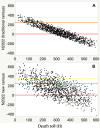Uncertainty and precaution in hunting wolves twice in a year
- PMID: 35294446
- PMCID: PMC8926205
- DOI: 10.1371/journal.pone.0259604
Uncertainty and precaution in hunting wolves twice in a year
Abstract
When humanity confronts the risk of extinction of species, many people invoke precautions, especially in the face of uncertainty. Although precautionary approaches are value judgments, the optimal design and effect of precautions or lack thereof are scientific questions. We investigated Wisconsin gray wolves Canis lupus facing a second wolf-hunt in November 2021 and use three legal thresholds as the societal value judgments about precautions: (1) the 1999 population goal, 350 wolves, (2) the threshold for statutory listing under the state threatened and endangered species act, 250 wolves; and (3) state extirpation <2 wolves. This allows us to explore the quantitative relationship between precaution and uncertainty. Working from estimates of the size wolf population in April 2021 and reproduction to November, we constructed a simple linear model with uninformative priors for the period April 2021-April 2022 including an uncertain wolf-hunt in November 2021. Our first result is that the state government under-counted wolf deaths in the year preceding both wolf-hunts. We recommend better scientific analysis be used when setting wolf-hunt quotas. We find official recommendations for a quota for the November 2021 wolf-hunt risk undesirable outcomes. Even a quota of zero has a 13% chance of crossing threshold 1. Therefore, a zero death toll would be precautionary. Proponents for high quotas bear the burden of proof that their estimates are accurate, precise, and reproducible. We discuss why our approach is transferable to non-wolves. We show how scientists have the tools and concepts for quantifying and explaining the probabilities of crossing thresholds set by laws or other social norms. We recommend that scientists grapple with data gaps by explaining what the uncertainty means for policy and the public including the consequences of being wrong.
Conflict of interest statement
The authors declare no financial competing interests. AT discloses the following non-financial, potential competing interests. Professional service to organizations or editorial boards Board of director (unpaid): President, Future Wildlife (2020), Board member Wildlife for All (Sep. 2021-present) Science advisor (unpaid): Project Coyote (2012–) Northeast Wolf Coalition (2014–) Endangered Species Coalition (2016–) Friends of the Wisconsin Wolf (2015–) Living with Wolves (2016–) Rocky Mountain Wolf Coalition (2018–2021) Earth and Animal Advocates (2019–) Benton County’s Agriculture and Wildlife Protection Program (2018–) Wild Earth Guardians (2020–) Member (unpaid): Union of Concerned Scientists (2015–), IUCN Bear Specialist Group task-force on human-bear conflicts (2012), IUCN Wolf specialist (2016–), Public Employees for Environmental Responsibility (2015–2019). Expert declarations (unpaid): Wi Federated Humane Societies et al. v Stepp. 2013. WI Court of Appeals District IV; WEG v Colorado Parks and Wildlife Commission et al. 2017. District Court, Denver Country, Colorado; Western Watersheds Project et al. v USDA Wildlife Services. 2018. U.S. District Court for the District of Idaho 1:17-cv-00206-BLW Doc 22-3; CBD & Cascadia Wildlands v WDFW 2018. Superior Court of Washington for Thurston County. 18-2-04130-34. CBD v WDFW et al. 2019. Superior Court of Washington for Thurston County, 18-2-02766-34. Huskin et al. v WDFW et al. 2019. Superior Court of Washington for King County 19-2-20227-1 SEA. Great Lakes Wildlife Alliance et al. v. Cole et al. Circuit Court Dane County, Wi 2021cv002103 Branch 9 Circuit Court Summons Dane County, WI, Case 2021CV002103 Document 5 Filed 08-31-2021 Paid service as external reviewer or speaker: Swiss-NSF SPARK (2019), Antioch University of New England (2018–2020), Landmark Foundation (2017), various publishers (2007–2017), U.S. Fish & Wildlife Service (2019), French Ministry of Environment, Scientific Council on Wolves (208-present), Ministry of Environment, Alfred Toepfer Academy for Nature Conservation, Lower Saxony, Germany (2021-present), NABU, Germany (2015, 2021) This does not alter our adherence to PLOS ONE policies on sharing data and materials.
Figures




References
-
- The United Nations Conference on Environment and Development. Rio declaration on environment and development. United Nations; 1992. - PubMed
-
- Wikipedia. Precautionary principle. Wikipedia [Internet].Accessed 29 January 2022. Archived: /web/20220129155106/https://en.wikipedia.org/wiki/Precautionary_principle.
-
- Groom MJ, Meffe GK, Carroll T. Principles of conservation biology, 3rd edition. Sunderland, MA: Sinauer Associates; 2007. doi: 10.1111/j.1523-1739.2006.00627.x - DOI
-
- Tennesee Valley Authority v Hill. 1978, U.S. Supreme Court 437 U.S. 153.
-
- Plater ZJB. Endangered species act lessons over 30 years, and the legacy of the snail darter, a small fish in a pork barrel. Environmental Law. 2004;34(2):289–308.
Publication types
MeSH terms
LinkOut - more resources
Full Text Sources
Miscellaneous

